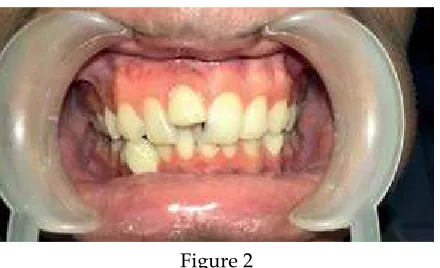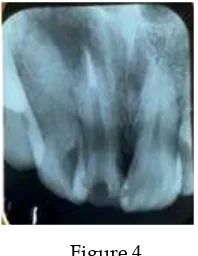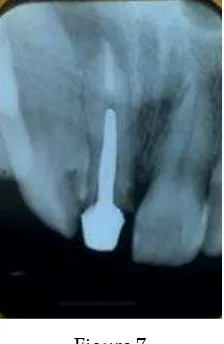VOLUME 6 No. 2, 22 Juni 2017 Halaman 59-138
MaNaGEMENt Of MIsaLIGNED CrOWN fraCtUrE WItH
EXtErNaL rOOf rEsOrPtION UsING MINEraL trIOXIDE
aGGrEGatE (Mta) aND CUstOM Cast POst aND COrE
rEstOratION
Rebecca Azary Kuncoro
dan
Yulita Kristanti
Conservative Dentistry Resident- Faculty of DentistryUniversitas Gadjah Mada Email: [email protected]
aBstraK
Crown fracture adalah luka traumatis yang paling banyak dilaporkan terjadi pada gigi permanen. Salah satu respon yang tidak menguntungkan terhadap trauma adalah perkembangan resorpsi akar eksternal (ERR). Cedera juga dapat menyebabkan perubahan angi gigi sehingga harus ditangani dengan tiang dan inti yang disesuaikan untuk menghasilkan hasil estetika yang lebih baik dan untuk mendapatkan kekuatan tekan
yang cukup. Laporan kasus ini menjelaskan penggunaan agregat trioksida mineral (MTA) sebagai sumbat
apikal untuk mendorong penyembuhan periapikal pada apeks terbuka dan penggunaan tiang dan inti cor
khusus untuk memperbaiki angulasi gigi. Laporan kasus. Seorang pasien laki-laki berusia 23 tahun datang
ke RSGM Prof. Soedomo dengan keluhan utama retak dan labial yang tidak sejajar dengan gigi insisivus kanan atas karena trauma 10 tahun yang lalu. Pasien menyatakan keengganannya untuk mendapatkan terapi
ortodontik. Uji perkusi dan palpasi tidak menunjukkan ketidaknyamanan atau rasa sakit. Tidak ada mobilitas
yang diperhatikan. Radiograf menunjukkan radiolusen periapikal dan apeks terbuka. Gigi diobati dengan saus
kalsium hidroksida dan sumbat apikal MTA ditempatkan di bagian apikal kanal. Gigi dipulihkan dengan tiang
dan inti cor khusus untuk memperbaiki angulasi diikuti dengan penempatan mahkota porselen. MTA dapat
digunakan sebagai plug apikal untuk menyegel apex terbuka yang disebabkan oleh ERR yang dikombinasikan dengan tiang dan inti cor khusus untuk pilihan lain untuk gigi yang tidak sejajar.
Kata Kunci: Agregat trioksida mineral; Custom cast post and core; Pergantian gigi berubah Resorpsi
akar eksternal.
aBstraCt
Crown fracture is the most commonly reported traumatic injuries in the permanent dentition. One of the unfavorable response to trauma is the development of external root resorption (ERR). Injuries may also cause tooth angulation changes so it should be treated with a customized cast post and core to produce better aesthetic result and to obtain suficient compressive strength. The case report describes the use of mineral trioxide aggregate (MTA) as an apical plug to promote periapical healing of an open apex and the use of custom cast post and core to correct the tooth angulation. Case report.A 23-year-old male patient came to RSGM Prof. Soedomo with a chief complaint of a fractured and labial misaligned of upper right central incisor due to trauma 10 years ago. Patient expressed his unwillingness to get orthodontic therapy. Percussion and palpation test showed no discomfort or pain. There was no mobility noticed. Radiograph showed periapical radiolucency and open apex. Tooth was treated with calcium hydroxide dressing and MTA apical plugs were placed in the apical portion of canals. Tooth was restored with custom cast post and core to correct the angulation followed by the placement of an porcelain crown. MTA can be used as apical plug for sealing open apex caused by ERR combined with custom cast post and core for other option for misaligned tooth.
Keywords: Custom cast post and core; External root resorption; Mineral trioxide aggregate; Tooth
INtrODUCtION
Crown fracture is the most commonly re -ported dental injuries and the highest percent-age of all traumatic injuries in the permanent dentition. One of the unfavorable response to trauma is the development of external root re-sorption (ERR) as a result of a long-standing infected root canal system. External root resorp-tion is an irreversible loss of external tooth struc-ture. Its etiology is multifactorial, but in many
aspects remain unclear. Periapical inlammation
sustained by infection can cause apical root
re-sorption in permanent teeth. The infection may
be asymptomatic for many years, althoughit is
rarely misdiagnosed. Treatment of such lesions
should include use of intracanal medicaments for complete debridement of the microbes
The conventional therapy of dental injury of a tooth with root resorption includes the use
of calcium hydroxide in an attempt to stop the
inlammatory root resorption and formation
of a hard tissue apical barrier. Neverthless, the use of calcium hydroxide has a negative as-pect, such as the possibility of increased root fracture. Recently, mineral trioxide aggregate
(MTA) has been suggested for use as an apical
plug to promote periapical healing of an open
apex. MTA is composed of calcium, silica, and
bismuth. It has a long setting time, high pH,
and low compressive strength. It possesses
some antibacterial and antifungal properties,
depending on its powder-to-liquid ratio. MTA
also has good sealing ability, biocompatibility,
and low cytotoxicity with a pH of 12,5 and sets
in the presence of moisture in approximately
four hours. Although properties of MTA are well described in the literature, MTA has not been employed very frequently in the
treat-ment of external root resoption. The following
case report demonstrated nonsurgical pulp space therapy of severe external root
resorp-tion and the use of MTA as an apical plug to
promote periapical healing of an open apex
combined with custom cast post and core res -toration.
Case
An 23-year old male patient came to the
postgraduate clinic of the Department of
End-odontic on RSGM Prof Soedomo, Gadjah Mada
University, Yogyakarta, Indonesia for continu -ing treatment of a traumatic injury of his
per-manent maxillary right central incisor. The patient’s chief complaint was an unaesthetic of labially misaligned fractured crown of maxil -lary right central incisor caused by traumatic
injury 10 years ago (Figure 1 and 2).
Figure 1
Labially misaligned crown fracture due to
mechanical trauma taken from the right side
Figure 2
Labially misaligned crown fracture due to
mechanical trauma taken from the front side
His medical history was non-contribu -tory. Clinical examinations revealed labially misaligned of maxillary right central incisor.
Percussion and palpation test showed no dis
-comfort or pain. There was no mobility no -ticed. On radiographic examination (Figure
3) showed periapical radiolucency and pro
-gressive inlammatory external root resorp-tion on the external apical surface of the root of maxillary right central incisor and open root
in 11. Taking into consideration the extent and the severity of the resorption, it was planned for orthograde MTA obturation of the canal
space to arrest the resorption and treatment for unaesthetic misalignment tooth.
Figure 3
Radiographic examination showed periapical radiolucency and progressive inlammatory
external root resorption on the external apical surface of the root of maxillary right central
incisor and open root apex.
Case Management
The tooth were isolated and an access cav
-ity was made, working length was established with help of apex locator, Propex-pixi (
Dentsp-ly) and Step-back preparation technique was performed with K-iles (Maillefer Dentsply,
Baillaigues, Switzerland). Canal was irrigated copiously with 5,25% sodium hypochlorite and followed by irrigation with normal saline
to remove any remnants of hypochlorite, canal
was dried with absorbents points and calcium
hydroxide (Ultradent) as an intracanal
me-dicament was placed in canal followed by a temporary restorations for 1 week. This proce
-dure was repeated three times. After 3 weeks, temporary restorations were removed, canal was cleaned and dried. MTA, pro-Root MTA
(Dentsply, Tulsa Switzerland) was manipulat
-ed with sterile water in a 3:1 powder to liquid
ratio according to manufacture instructions.
The canal was obturated with MTA on the 5 mm apical portion of the canal. Material was
placed in the canals and condensed vertically
with hand pluggers (Figure 4).
Figure 4
The canal was obturated with MTA on the 5 mm apical portion of the canal. Material was placed
in the canals and condensed vertically to make an apical plug to close the open apex.
After completion of apical sealing using
MTA, postendodontic restoration was pre
-pared. The remaining tooth structure was pre
-pared with shoulder inish line on labial side and chamfer on the palatal side. The length of the post was determined from periapical ra
-diograph and peeso reamer was used to pre
-pare the postspace. The custom dowel post and core was made by impress the postspace using
polyvinylsiloxane double impression material
(Exalex, GC, Japan) to produce an accurate dental cast. Cast is poured with type IV den
-tal stone to make a pattern for postspace. The pattern then was invested and a metal
single-unit cast post and core can thus be fabricated
out of orden. The core was design to change
the angulation of the misalignment tooth into the appropriate inclination (Figure 5). Over the cast core, lithium disilicate crown was placed to make an aesthetic restoration (Figure 7).
Figure 5
Custom cast post and core was made with the speciic design to change the angulation of
Figure 6
The aesthetic restoration made from lithium
disilicate crown added with gingival color on the cervical region to enhance the aesthetic result
(front side)
rEsULt aND DIsCUssION
External root resorption is a pathologic condition caused by several etiological factors,
such as inlammatory response that is initiated by mechanical trauma. When the endodontic
treatment is delayed, pulpal infection
associ-ated with periodontal ligament damage may
result in the progression of inlammatory ex
-ternal resorption. The presence of bacteria and
their by-products inside the root canal system and dentinal tubules after pulp necrosis and in the absence of protection of cementum barriers may lead to root resorption. Resorption of the mineralized strucutres of the teeth is carried out by the multinucleated resorbing cells called
odontoclasts. Treatment protocol for an exter-nal root resorption should involve elimination of bacteria and their products from root canal
system to stop the inlammatory processes in
-volving the root surface to allow the regenera
-tion of periodontium. The major challenges in
endodontic treatment of teeth with open api -ces due to resorption are achieving complete debridement, canal disinfection, and optimal sealing the goal of endodontic treatment is to form an apical stop on the third apical portion of the root to achieve apical barrier and avoid-ing over extrusion.
Recently mineral trioxide aggregate
(MTA) has been recomended for various uses
in endodontics due to its good sealing ability,
antibacterial activity, and biocompatibility. It also encourages regeneration of peri-radicular tissues such as periodontal ligament bone and
cementum. In the present case, there was se
-vere inlammatory extrenal resorption in the apical portions of the root associated with
periapical pathology that cause apical open-ing. After chemomechanical preparation of the root canal system, calcium hydroxide dressing
was placed to provide an alkaline pH inside
the dentinal tubules to kill the bacteria and
neutralize the endotoxins, which are potent in
-lammatory stimulators.
As the tooth has an apical opening due to
external resorption, treating it by MTA as an
apical plug can also cause release of calcium ions through dentinal tubules into external resorption defect. In the case described here,
3 month radiographic recall showed osseous repair of periapical pathosis (Figure 6). The patient was asymptomatic and no mobility
noticed. Custom cast post and core was used
combined with the MTA apical plug because
the need of angulation changing of the mis-alignment tooth. Custom cast post and core is
a single assembly in which core can be shaped
until satisfactory aesthetic is achieved although the core might not be in the same axis as the
post. Figure 7. showed the aesthetic restoration
made from lithium disilicate crown added with gingival color on the cervical region to enhance the aesthetic result.
Figure 7
Three month radiographic recall showed osseous repair of periapical pathosis. The patient was
Figure 8
The aesthetic restoration made from lithium
disilicate crown added with gingival color on the cervical region to enhance the aesthetic result
(front side)
Figure 9.
The aesthetic restoration made from lithium
disilicate crown added with gingival color on the cervical region to enhance the aesthetic result
(right side).
CONCLUsIONs
MTA can be used as an apical plug for
sealing apical opening of the root canal caused by External Root Resorption combined with custom cast post and core and lithium dis-ilicate aesthetic restoration for treating mis-aligned tooth.
BIBLIOGraPHy
Nayak MT, Nayak A. External inlammatory root resorption in mandibular irst
molar : a case report. Malays J Med
Sci. 2015;22(6): 63-66. [Journal Article] Andreasen JO, Farik B, Munksgaard EC.
Long-term calcium hydroxide as a root canal dressing may increase
risk of root fracture. Dental Trauma-tology. 2002;18(3) 134-137. [Journal Article]
Sharii R, Parirokh M, Satvati SAR, Tora-binejad M. Treatment of in
inlam-matory root resorption using mineral trioxide aggregate: A case report.
Dental Hypotheses. 2014;5(4):172-174. [Journal Article]
Parirokh M, Torabinejad M. Mineral trioxide aggregate: A comprehensive
litera-ture review-partI: chemical, physical,
and antibacterial properties. J Endod,
2010;36:16-27. [Journal Article] Torabinejad M, Parirokh M. Mineral trioxide
aggregate: A comprehensive
litera-ture review-partII: chemical,
physi-cal, and antibacterial proper ties.
J Endod, 2010;36:16-27. [Journal Article]
Agrawal VS, Kapoor S. Clinical management
of severe external root resorption and
immature open apex with MTA and
calcium hydroxide, A case report. Endodontology. 83 – 88. Available
from: http://medind.nic.in/eaa/ t11/i2/eaat11i2p81.pdf accessed on 8.7.2017. [Website]
Utneja S, Garg G, Arora S, Talwar S.
Nonsurgical endodontic retreatment
of advanced inlammatory external root resorption using mineral trioxide aggregate obturation. Case
Rep Dent 2012. [Journal Article]. Levin L, Trope M. Root resorption in dental
pulp, K. Hargreaves and H Goodis,
Eds., pp. 425-448. St. Louis : Elsevier, 2002. [Book]
Raldi DP, Mello I, Habitante SM,
Lage-Marques JL, Coil J. Treatment options for teeth with open apices
and apical periodontitis. J Can
Dent Assoc. 2009;75:591–6. [Journal Article]
Cehreli ZC, Sara S, Uysal S, Turgut MD. MTA apical plugs in the treatment of traumatized immature teeth
with large periapical lesions. Dent Traumatol. 2011;27:59–2. [Journal Article]
Mohammadi Z, Yazdizadeh M, Khademi A. Sealing ability of MTA and a new root illing material. Clin Pesg Odontol Curtitiba. 2006;2:367–71. [Journal Article]
Fuss, Z., Tsesis I, Lin S., Root resorption – diagnosis, classiication and treat-ment choices based on stimula tion
factors, Dental Traumatollgy (19)4: 175-182, 2003. [Journal Article]
Singh K, Kumar N, Choudhary N, Gupta N. Unconventional prosthodontics for aesthetic rehabilitation of dis-co loured rotated maxillary central



